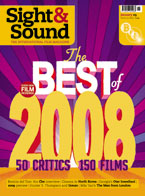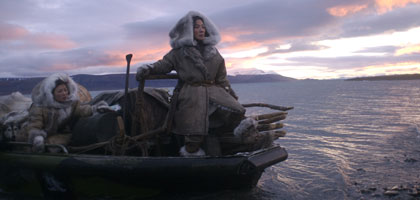
Far North
UK/France 2007

Reviewed by Jonathan Romney
Synopsis
Our synopses give away the plot in full, including surprise twists.
The Arctic. Saiva - once a solitary outcast, supposedly cursed - is now accompanied on her travels by Anja, a young woman she raised from a baby after Anja's settlement was wiped out by the soldiers taking over their homeland. One day the two women rescue Loki, a man found wandering in the tundra; he too is a fugitive. The three continue travelling together and, despite Saiva's warnings, Anja becomes Loki's lover. Anja tells Saiva that she is tired of the nomadic life and is leaving to start a family with Loki. Saiva kills Anja, slices off her face and wears it to make love to an unwitting Loki; when he realises what is happening, he runs off into the wilderness.
Review
Asif Kapadia's 2001 debut feature The Warrior remains one of the most singular and adventurous enterprises in recent British cinema: a dazzling fusion of traditional Indian imagery with martial-arts action and the stylised starkness of the Sergio Leone Western. A follow-up has been long awaited and Far North - premiered in Venice in 2007 - could be considered Kapadia's second feature proper, his 2006 film The Return, a Sarah Michelle Gellar scarer, being strictly a for-hire job.
Far North is nothing if not adventurous and shows the same thirst for exploration that made The Warrior such a stirring anomaly. Just as that film was largely inspired by its location, Far North starts out not so much from a narrative base - although the seed was a short story by Sara Maitland - as from a landscape, its visual palette and its expressive ambience. Here, the story serves to help explore the setting rather than the other way round.
Shot in the Norwegian Arctic and in the extreme northern archipelago of Svalbard, the film bears the traces of what was by all accounts an unusually arduous production, the shoot sometimes happening at minus 40 degrees. The landscape is the film's true subject, as was not strictly the case in The Warrior, where a compellingly schematic narrative and the charismatic presence of Irfan Khan held equal claims on the attention. In Far North, however, the geography itself results in a more contemplative, downbeat mood. Kapadia and Roman Osin, returning as DP, are working with a greatly reduced colour palette: snow, brown land, grey rock, occasional splashes of blood and glows of fire as opposed to the intense blue skies and red sands of The Warrior's location, Rajasthan. Nevertheless, Far North often provides an intensely impressionistic experience - although, oddly, it is sometimes less striking visually than sonically, the grumbling and cracking of ice fields and the subsonic booms of the water beneath forming an eerie soundscape that makes Dario Marianelli's sparse, new-agey score somewhat redundant.
Yet the film falls short of the mythic heft it seeks in its stripped-down narrative, about the outcast Saiva and the young woman, Anja, who accompanies her on her travels. One of the problems is the context: we neither quite believe in the generalised timelessness of the landscape nor in the hints of geographic specificity. In this unidentified landscape, characters speak English, and at one point, in the background, Russian. The two women are presumably to be taken as Inuit, given the casting of Malaysian-born Hong Kong star Michelle Yeoh and Asian-American Michelle Krusiec - while the provenance of Loki, the man who comes between them, is unclear, his name suggesting affinities with the malign Norse god.
Any potential substance to these barebones characters is undermined by the terse but awkward English dialogue ("How's the reindeer?" "Tough"), with which the actors never sound comfortable. Stiff playing, and distracting American inflections in the two women, prove such liabilities that you wish Kapadia had gone the extra mile and eschewed dialogue entirely, an approach that might well have yielded a tougher film (though it would have limited its commercial prospects still further). And, while few actors are quite as adept as Sean Bean at stumbling out of a tundra and looking battered by the elements, it's nevertheless hard to forget that this is Sean Bean: the connotations of solid action-role bluffness are hard to shake off.
A bleak and abrupt ending, aspiring to the extremity of primal myth, comes across as an incongruous switch of register, with an unfortunate echo of Hannibal Lecter's impromptu mask-making in The Silence of the Lambs. Far North falls far short of the echt-Inuit resonance of Zacharias Kunuk's geographically specific Atanarjuat (2000), yet it does often hit a note of genuine mystery and otherworldliness. Scenes in which the women pass a prison-like encampment, or in which we glimpse a cluster of geodesic domes, suggest an almost science-fiction quality, as if we're really on another planet. The film takes on its own life the more it drifts away from the strictly human dimensions of the drama and gestures at something more evocatively abstract - which is when it develops affinities with the more exigent landscape-art and durational tendencies of film-makers such as Philippe Grandrieux or Lithuania's Sarunas Bartas. For all its flaws, Far North remains as strikingly non-conformist as its predecessor; you wonder what revelations Kapadia might yet give us if he girds himself to venture into the more recondite territories this film gestures towards.
Credits
- Director
- Asif Kapadia
- Producer
- Bertrand Faivre
- Screenplay
- Asif Kapadia
- Tim Miller
- Based on the story True North by Sara Maitland
- Director of Photography
- Roman Osin
- Editor
- Ewa J. Lind
- Production Design
- Ben Scott
- Music/Music Orchestrated and Conducted by
- Dario Marianelli
